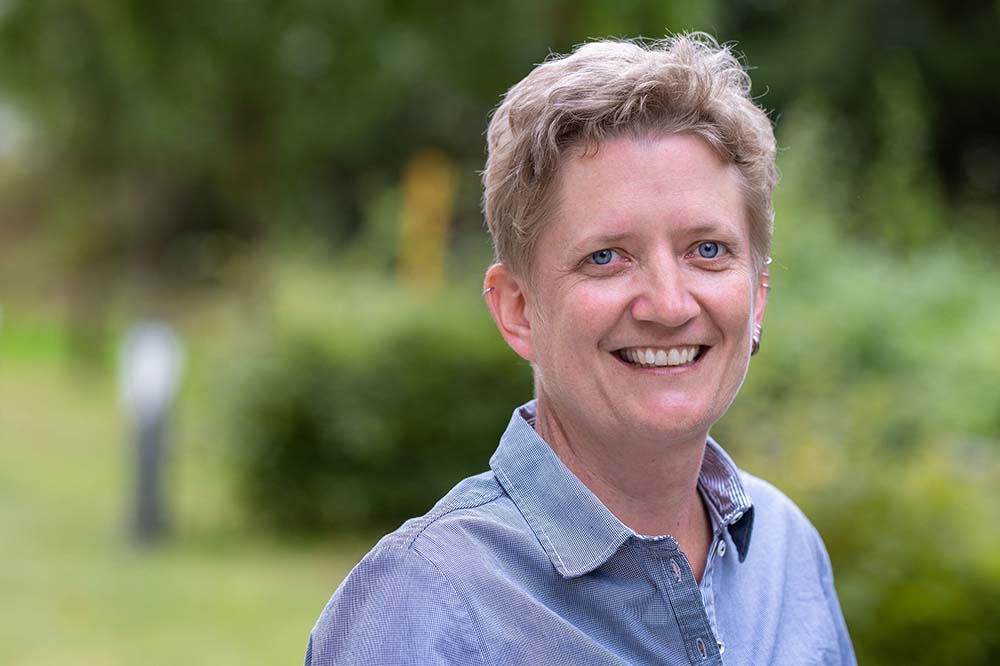
Tracking cellular hiding spaces
03.11.2022 / Text: Alexandra von Knobloch / Fotos: Sascha Mannel
Tracking cellular hiding spaces
Flaviviruses cause diseases that are sometimes harmless – but sometimes fatal or cause severe morbidity. There are no therapies yet. Prof. Dr. Eva Herker tries to attack these viruses while they are hiding from the immune system.
A real advance in medical care – Prof. Dr. rer. nat. Eva Herker has already witnessed it in her career. After completing her doctorate, the biochemist began research on hepatitis C virus in 2006. At that time, liver inflammation caused by this virus was difficult to treat if it was chronic – which it was in eight out of ten cases. Those affected were threatened with liver damage, cirrhosis, and their risk of liver cancer increased significantly.
The existing therapy was long and came with high burden for the patients, with only moderate chances of success. Then, in 2010, protease inhibitors were approved as active ingredients for treatment and were rapidly developed further. Since 2014, the cure rate for hepatitis C has been 95 percent. Treatment is completed after a few weeks. At least in the highly developed countries, hepatitis C is not as threatening as it was any more.
Dengue, yellow fever, Zika and co. are all related
Alleviate the burden of disease: That’s one of the basic motives behind research at the LOEWE Center DRUID. With her professorship funded by the LOEWE Center, Eva Herker and her 6-member team at the University of Marburg are working on this in the field of viruses. Her in-depth experience with the hepatitis C pathogen is seamlessly integrated into her research on neglected tropical diseases, which often hit poor people particularly hard. The viruses that the 45-year-old is working on within the DRUID project are very similar to the hepatitis C virus.
Dengue, yellow fever, Zika, West Nile, and tick-borne encephalitis viruses are on Herker’s to-do list. They all are flaviviruses, and related to hepatitis C virus, as they all belong to a family of positive-stranded RNA viruses, the Flaviviridae. And although they are not identical, they show similar features. Flaviviruses can cause severe infections from which affected individuals die or survive only with severe morbidities, such as brain damage or paralysis.
The viruses make the host cells work for them
Herker’s goal is to find targets for potential drug candidates against selected flaviviruses. To this end, she investigates how viruses alter lipid metabolism of their human hosts in such a way that the host cell produces small lipid-containing vesicles – a kind of capsule – in which the viruses multiply. Lipids (or fat) are molecules that do not dissolve in water. They form essential components of the boundary structures of cells, the membranes.
The flaviviruses that Herker’s research group studies all replicate in vesicles at roughly the same place in the cell, the so-called endoplasmic reticulum. This is similar for the hepatitis C virus, but the versicles have a different structure. “The similarities of the flaviviruses we work with make it more likely to find a target that inhibits all of them”, the biochemist explains.
Tracking changes in the microscope
How that might work? The vesicles around the viral RNA don’t just serve to replicate the RNA. Within them, viruses also hide from the immune system of the host cells. “The cells or organisms do not even notice that they are infected,” Eva Herker reports. If the formation of these vesicles could be prevented with a drug, the researcher hopes, the cells could detect the infection and fight it with their own weapons. In order to test whether this theory is correct, Herker modifies the host cells, among other things, and investigates what happens when viruses encounter host cells in which certain metabolic processes can no longer take place.
To evaluate her experiments, Herker often uses imaging techniques such as fluorescence microscopy or electron microscopy: the latter in a collaboration with Professor Jacomina Krijnse Locker (insert link to this portrait later). Eva Herker also shares a fascination for the theory of existence of viruses with her, because despite their extremely simple structure, they represent an enormous challenge for science and medicine. “Zika, West Nile fever, dengue fever, yellow fever or tick-borne encephalitis: there are no causal treatments for any of these diseases yet,” Herker points out. “That’s because we still know by far not enough in detail about how flaviviruses subvert host cells.”
What role does malnutrition play in the infection?
In her search for similarities between several representatives of this virus genus, Herker also always keeps an eye on the differences. There could be one that turns out to be the key to better understanding the entire virus-host system. This is one of the reasons why the tick-borne encephalitis virus is on Herker’s list. As its name implies, it’s transmitted by ticks, not mosquitoes like the others. Does it therefore have different host metabolism requirements?
In order for Eva Herker to investigate her scientific questions in the different viruses, she needs methods that are fast and allow working in parallel. Many of the methods Herker’s group uses have only been applicable in cell biology research for a few years. And Herker plans to continue: “I’m also interested in how the metabolic state of the host affects the reproductive success of the viruses,” she says. After all, viral tropical diseases often hit malnourished people particularly hard. Malnutrition alters the lipid metabolism of cells. Does it make it easier for viruses to spread? If so, how?
The desire: biochemistry with medical relevance
How viruses alter cells in their favor and thus affect whole organs is on top of Eva Herker’s research agenda: This is why the lab is working on recreating the organs that are often most affected by flaviviruses – the liver and brain. Such organ models, which can now be grown from stem cells, are called organoids. They can also be used to mimic different health conditions – such as the fat metabolism and malnutrition.
“Medical relevance in my research is important to me,” Herker says. But she likes to place herself at the very beginning, at basic research, in the chain of work that creates medical progress. “Providing ideas that are mature enough for others to pick up on,” she says, is the purpose of her science.
Originally from Nuremberg, Eva Herker first studied biochemistry in Potsdam. Because the class there focused too much on plants for her interests, she moved to Tübingen after her intermediate diploma, and completed her diploma and doctoral thesis there. Her research focused on the cell death processes of yeasts, unicellular fungi.
Learning from other fields
In the long run, even that was still too far away from medicine, Herker thought, and applied for a scholarship that specifically supports young scientists who want to change their field of research and are willing to do so abroad. This is how Eva Herker ended up at the Gladstone Institutes in the San Francisco Bay Area in the USA in 2006 – and with hepatitis C virus.
Back in Germany, she continued to work on this disease-causing virus as head of a junior research group at the Leibniz Institute of Virology in Hamburg. Since December 2018, Eva Herker has been a professor for molecular virology at the University of Marburg. Here, she continues to work in part with hepatitis C virus and, through the DRUID project, increasingly with flaviviruses. “After all, one idea of DRUID is to transfer things that already work in one area to other areas if possible,” Herker reports. Her expertise in hepatitis C virus provides a broad basis for this.
Contact

Prof. Dr. Eva Herker
Institut für Virologie
Philipps-Universität Marburg
Hans-Meerwein-Str. 2
35043 Marburg
Tel.: +49 (0)6421-28-64525
E-Mail: eva.herker(at)uni-marburg(dot)de









